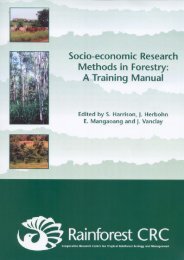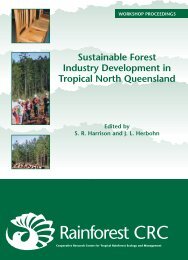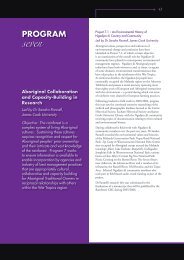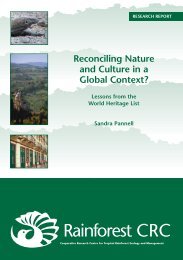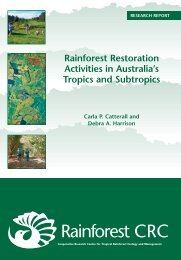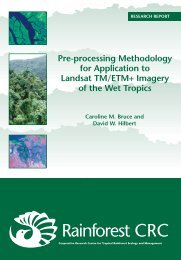S<strong>and</strong>ra PannellIn the same way that Annette We<strong>in</strong>er argues that there are some objects which are neverexchanged because of their acknowledged capacity to authenticate cosmology (1992), thenthere are some places which, regardless of their disfigurement or, <strong>in</strong> some cases, completeobliteration, cont<strong>in</strong>ue to be socially recognised as important loci for the convergence ofmemory <strong>and</strong> mean<strong>in</strong>g. In other words, some places <strong>in</strong>vite commentary <strong>and</strong> people tellstories about them. Aga<strong>in</strong>, similar to We<strong>in</strong>er’s ‘<strong>in</strong>alienable possessions’, these places are notisolated ‘memory palaces’ (Yates 1966). Rather, their uniqueness derives from thosecultural traditions, which l<strong>in</strong>k these sites <strong>in</strong>to a wider netscape of memory.As these comments suggest, <strong>and</strong> as Paul Carter (1987) rem<strong>in</strong>ds us, space is not simply abackdrop or stage upon which significant events take place or are <strong>in</strong>scribed upon.L<strong>and</strong>scapes <strong>and</strong> places are implicated <strong>in</strong> dynamic social processes of memory-mak<strong>in</strong>g <strong>and</strong>forgett<strong>in</strong>g, as well as be<strong>in</strong>g one of the products of these ongo<strong>in</strong>g processes. In Massey’sterms, space is part of “an ever-shift<strong>in</strong>g social geometry of power <strong>and</strong> signification” (1994: 3).This is brutally evident <strong>in</strong> places like Bosnia <strong>and</strong> Herzegov<strong>in</strong>a which, to paraphrase EdwardSaid (1993: 7), can be regarded as ‘geographies which struggle’, disturb<strong>in</strong>g the notion ofspace as somehow <strong>in</strong>herently fixed or settled.Rather, than regard<strong>in</strong>g these violated spaces or disfigured places as ‘non-places’ (cf. Auge1995) or aesthetic blights on the l<strong>and</strong>scape, readily shunned or removed <strong>in</strong> the first wave ofrebuild<strong>in</strong>g a community or creat<strong>in</strong>g a new nation, these ‘troubled’ spaces occupy animportant place <strong>in</strong> the social consciousness of a people. As the Rw<strong>and</strong>a example suggests,the violations enacted on place not only st<strong>and</strong> as powerful memorials of violent events <strong>and</strong>histories but they can also give shape to ongo<strong>in</strong>g social processes of reformation <strong>and</strong>reconciliation.In light of the preced<strong>in</strong>g discussion, we can ask the question, how does a society rememberits past or configure its future? In the context of recent theatres of war <strong>in</strong> Europe, Africa, <strong>and</strong>Asia, this is not an academic question but is one, which has widespread social <strong>and</strong> politicalimplications. In the post-war period <strong>in</strong> many of these war-torn places, with the emphasisupon re<strong>in</strong>stat<strong>in</strong>g fundamental amenities, such as health, water, sanitation, hous<strong>in</strong>g, etc., <strong>and</strong>redevelop<strong>in</strong>g the built environment, this question takes on an added impetus.In war-torn <strong>and</strong> transformed l<strong>and</strong>scapes, identify<strong>in</strong>g what constitutes the cultural heritage of agroup or a nation is not an obvious or simple matter. The issue here is not purely a matter ofdeterm<strong>in</strong><strong>in</strong>g how to memorialise a tragic past <strong>in</strong> spatial terms, though this is a significantconsideration. Often, efforts to monumentalise events <strong>and</strong> experiences <strong>in</strong> this wayunderstate the fact that social memories are conveyed <strong>and</strong> susta<strong>in</strong>ed through embodied,spatialised experiences. The issue here is how to preserve this progressive <strong>and</strong> engagedsense of place <strong>and</strong>, at the same time, recognise endur<strong>in</strong>g commemorative spaces.An exam<strong>in</strong>ation of the World Heritage List reveals a notable lack of places <strong>and</strong> spacesassociated with <strong>and</strong> def<strong>in</strong>ed by war <strong>and</strong> conflict. Indeed, as previously stated, spacesdisfigured, even obliterated by war <strong>and</strong> conflict do not readily meet the criteria <strong>and</strong> conditionsfor ‘outst<strong>and</strong><strong>in</strong>g universal value’ under the World Heritage Convention. While such placesmay signify monumental events <strong>in</strong> world history, structurally they do not conform to the ideasof <strong>in</strong>tact heritage def<strong>in</strong>ed by the Convention. The emphasis upon restoration as a means ofma<strong>in</strong>ta<strong>in</strong><strong>in</strong>g the <strong>in</strong>tegrity <strong>and</strong> authenticity values of a site necessarily precludes the list<strong>in</strong>g ofmany war-related properties, result<strong>in</strong>g <strong>in</strong> a situation where the World Heritage List practicallyignores a significant dimension of human history <strong>and</strong> heritage.58
<strong>Reconcil<strong>in</strong>g</strong> <strong>Nature</strong> <strong>and</strong> <strong>Culture</strong> <strong>in</strong> a <strong>Global</strong> <strong>Context</strong>?Lessons from the World Heritage ListAUSTRALIAN HERITAGE AND THE COLONIAL EXPERIENCEThe issue of recognis<strong>in</strong>g a ‘heritage that hurts’ (Uzzell <strong>and</strong> Ballantyne 1998) is one that manyformer colonies are still grappl<strong>in</strong>g with as they come to terms with <strong>and</strong> try to reconcile someof the more shameful episodes <strong>in</strong> their recent past. In Australia, for example, while the legalrecognition of native title attempts to redress contemporary Aborig<strong>in</strong>al dispossessionresult<strong>in</strong>g from the colonial imposition of the concept of terra nullius, for the most part thiscolonial past rema<strong>in</strong>s a ‘hidden history’ (Bird Rose 1991). When Aborig<strong>in</strong>al cultures areacknowledged as part of the ‘nation’s heritage’ or are recognised as World Heritage, it is notbecause they have somehow survived more than 200 years of European colonisation.Unlike Macau, there are few <strong>in</strong>stances <strong>in</strong> Australia of restor<strong>in</strong>g <strong>and</strong> preserv<strong>in</strong>g thearchitectural products of the encounter between Indigenous people <strong>and</strong> European colonists.Comparison with Macau <strong>and</strong> other former colonies <strong>in</strong>scribed on the World Heritage List hasobvious implications for future nom<strong>in</strong>ations by the Government of Australia <strong>in</strong>volv<strong>in</strong>gIndigenous cultural heritage. It is certa<strong>in</strong>ly time to reth<strong>in</strong>k the relationship between heritage<strong>and</strong> the ‘colonial experience’ if we are to progress beyond the view of Australian coloniall<strong>and</strong>scapes as a picturesque artistic legacy, epitomised by the Heidelberg School (Taylor1995), or the presentation of colonial spaces as surviv<strong>in</strong>g ‘palaces’ of empire, as epitomisedby the recently-listed (2004) Royal Exhibition Build<strong>in</strong>g <strong>and</strong> Carlton Gardens.If Macau represents one of the first <strong>and</strong> longest-last<strong>in</strong>g <strong>in</strong>teractions between East <strong>and</strong> West,then the <strong>in</strong>troduction of the ‘Reserve System’ by colonial authorities <strong>in</strong> Queensl<strong>and</strong> <strong>in</strong> 1896can make similar claims <strong>in</strong> the history of Indigenous <strong>and</strong> colonial encounters. Ostensiblyestablished to ‘protect’ Aborig<strong>in</strong>es from European <strong>and</strong> Ch<strong>in</strong>ese settlers <strong>and</strong> the allegeddebilitat<strong>in</strong>g moral <strong>in</strong>fluences of these two societies (Meston 1895: 24), the Queensl<strong>and</strong>system was the first of its k<strong>in</strong>d <strong>in</strong> Australia <strong>and</strong> variations of it were soon enacted <strong>in</strong> otherstates. So-called ‘protection’ entailed the mass <strong>and</strong> forced removal of Aborig<strong>in</strong>al people fromtheir traditional homel<strong>and</strong>s to one of the newly established settlements. Prior to theestablishment of the Government’s reserves, a number of church-run mission stationsalready existed, the first of these be<strong>in</strong>g set up <strong>in</strong> the 1870s <strong>in</strong> south-east Queensl<strong>and</strong>(Department of Aborig<strong>in</strong>al <strong>and</strong> Isl<strong>and</strong>ers Advancement 1982). In the Wet Tropics region,Yarrabah 55 was established by the Church of Engl<strong>and</strong> <strong>in</strong> 1892; Bloomfield River Mission was<strong>in</strong>itially a government settlement established <strong>in</strong> 1886, but then taken over by the LutheranMission Council of South Australia <strong>in</strong> 1887; Mona Mona Mission was founded by the SeventhDay Adventist Church <strong>in</strong> 1913; while the government-run Hull River Aborig<strong>in</strong>al Settlementbegan operat<strong>in</strong>g <strong>in</strong> 1914 (loc. cit.). By 1948, 18 Aborig<strong>in</strong>al <strong>and</strong> Isl<strong>and</strong>er reserves, missions,<strong>and</strong> settlements had been established <strong>in</strong> North Queensl<strong>and</strong> <strong>and</strong> on Cape York Pen<strong>in</strong>sulaalone (loc. cit.) 56 . As previously mentioned, Yarrabah <strong>and</strong> Wujal Wujal (formerly BloomfieldRiver Mission), together with the Mona Mona Reserve, were <strong>in</strong>corporated <strong>in</strong>to the boundariesof the Wet Tropics World Heritage Area (DASETT 1987). While no longer reserves ormissions, today Yarrabah <strong>and</strong> Wujal Wujal cont<strong>in</strong>ue to support large Aborig<strong>in</strong>al communities,while Djabugay people are redevelop<strong>in</strong>g the former mission site of Mona Mona.Most Aborig<strong>in</strong>al people liv<strong>in</strong>g <strong>in</strong> Queensl<strong>and</strong> have some form of direct or mediatedexperience of the reserve system as part of what it meant to live under the Act <strong>in</strong> then<strong>in</strong>eteenth <strong>and</strong> twentieth century 57 . Today, the architectural rema<strong>in</strong>s of the mission days atplaces like Yarrabah, Wujal Wujal <strong>and</strong> Mona Mona are salient rem<strong>in</strong>ders of the <strong>in</strong>justices of55 Yarrabah was formerly known as Cape Grafton <strong>and</strong> also as the ‘Bellenden Ker Mission’.56 In the 1960s, Aborig<strong>in</strong>al Reserves were also established at Ravenshoe <strong>and</strong> Mal<strong>and</strong>a <strong>in</strong> the WetTropics region.57 In its various manifestations, The Aborig<strong>in</strong>als Protection <strong>and</strong> Restriction of the Sale of Opium Act of1897 controlled Aborig<strong>in</strong>al lives <strong>in</strong> Queensl<strong>and</strong> until 1984 (Bottoms 1999: 87).59




